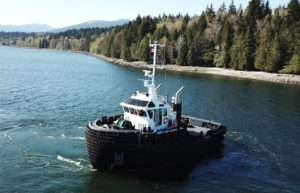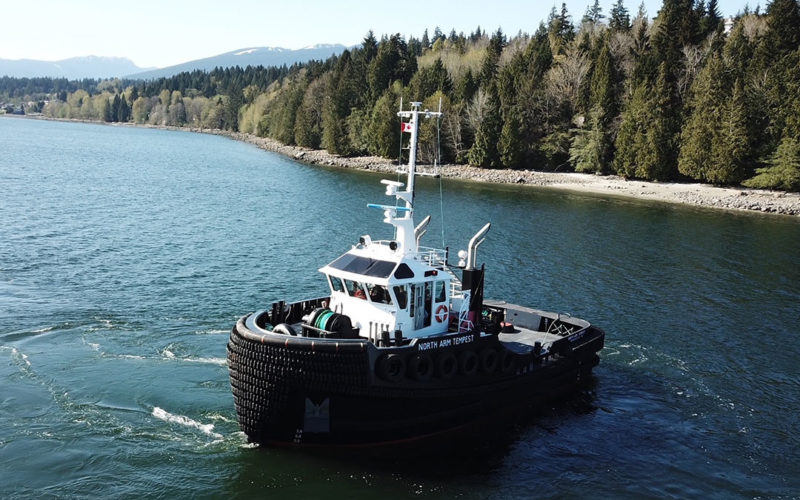
North Arm Transportation has added a versatile z-drive tugboat to its fleet of coastal towing vessels – and it’s already earning acclaim from captains.
“I love these Veth controls,” Capt. Ryan Scott said of the intuitive z-drive control system on North Arm Tempest, the first z-drive in the North Arm tugboat fleet.
Scott recently retired after 32 years with a large towing company based in Vancouver, British Columbia. North Arm officials hired him to train two crews on the new tugboat that will operate along the B.C. coast.
“For the last 15 years, I drove tractor tugs. I found this boat responds quickly, handles nice and walks very well,” Scott said in a recent interview.
He commended the quiet of the vessel’s design, courtesy of A.G. McIlwain, and the twin Cummins 1,000-hp KTA38 main engines. The Veth VZ-900 z-drives, with their 67-by-60-inch props in Veth VOB50 nozzles, are a first for British Columbia and are being praised for their simple but robust design.
The drives aren’t the only innovation on the new tugboat. North Arm Transportation tows fuel and general cargo barges along the B.C. coast. This can involve maneuvering barges into upcoast wharves and beaches with no assist boats. While B.C. skippers are noted for their abilities working in tide and handling barges at difficult landings, the z-drives introduce a whole new level of safety.
The new tugboat, built by North Vancouver’s ABD Boats, is an evolved cousin to the boatbuilder’s McIlwain-designed tug Renegade, delivered in 2012 for Standard Towing Ltd. At 64.9 by 27 feet with a 13.9-foot draft, the two boats have the same hull dimensions. They also share the same Cummins KTA38 engines.
North Arm’s fleet supervisor, Paul Kruse, has had extensive experience with the KTA38 engines. “These are mechanical engines, and have worked well in the Renegade. To address environmental and economic concerns, we have fitted them with optional fuel monitors,” he explained.
North Arm Tempest differs from Renegade with the choice of the Veth z-drives. This was done after careful and deliberate research – which included discussions with the owners of Seattle-based Western Towboat, who use z-drives on their long-haul boats, and Capt. Jack Davis, who had Renegade built to operate from Port McNeill on the north side of Vancouver Island.
North Arm Transportation has several boats, including ramp, fuel and flat barges serving the coastal communities and the logging, mining and tourist camps along the B.C. coast. The company was founded by the Stradiotti brothers in 1958, and this is their first new boat in many years – and, it is their first z-drive.
Success has come through versatility and the ability to adapt to evolving needs on the islands and inlets that make up the rugged B.C. coast. With that in mind, North Arm Tempest has a large Burrard Iron Works single-drum towing winch on the aft deck. The winch is loaded with 2,200 feet of 1.75-inch wire, plus two 400-foot pendants with links to allow up to three barges to be towed in tandem.
There is a Burrard Iron Works combination anchor and hawser winch on the foredeck. With controls on the wheelhouse console, the hawser winch is primarily designed for making up to barges but is also ready to be operated in ship-docking mode if required.
For optimum situational awareness, a full set of controls – with a clear view of both the hawser and the towing winches – are included on a flying bridge over the wheelhouse. This will be an invaluable asset when landing a ramp barge on a beach, or handling a fuel barge on the hip and alongside a pier. The mast is also equipped with hydraulics that enable it to be lowered for bridges.
In the wheelhouse, a set of aft-facing controls with an open view of the aft deck and Western Machine Works tow pins allow for control of the aft deck towing winch. The forward console, in addition to the two Veth z-drive controls, has a full slate of Furuno navigation tools, Icom communications, Veth engine controls and a Simrad autopilot.
The operator has access to other controls and switches from the helm chair, including two Carlisle & Finch searchlights mounted atop the flying bridge.
Down from the wheelhouse, a watertight door is mounted at the base of the companionway. When fully opened, it can pivot into the port-side galley, which is separated by a companionway from the starboard-side mess. The companionway leads forward in the raised fo’c’sle to four bunk rooms: two doubles and two singles. Additional stores and a washer and dryer are fitted into available spaces.
Aft of the accommodation area, a ladder leads to the front of the engine room. The space is well laid out, with plenty of room to access the two Cummins KTA38 mains and the two John Deere auxiliaries. Additional piping and controls allow for the hydraulics – powered by the two auxiliaries – to operate the winches, tow pins and other devices, including a man-overboard davit. A pair of large circular “donut” Harco exhaust silencers are mounted between the engines and the deckhead to provide efficient noise reduction. Aft of the engine room, a door and companionway lead to port and starboard drive rooms. The drives contain the clutches and are connected to the mains with carbon-fiber drive shafts and torsional couplings.
On the foredeck, the massively fendered bow and bulwarks are capped by a stainless-steel wear strip. The anchor chain leads down a hawsepipe to the anchor, mounted in a pocket in the hull. The Schuyler Cos. fendering extends all around the tug to a heavily fendered transom.
Sea trials proved North Arm Tempest to be comfortably quiet and, thanks to the Veth drives, well mannered and responsive. This is a boat that will be getting the well-deserved attention of other Pacific coast operators looking to update their barge towing fleet.

